By Leen Randell
Updated: Jul 04, 2024
10 Best Herbal Decoctions For Ringworm
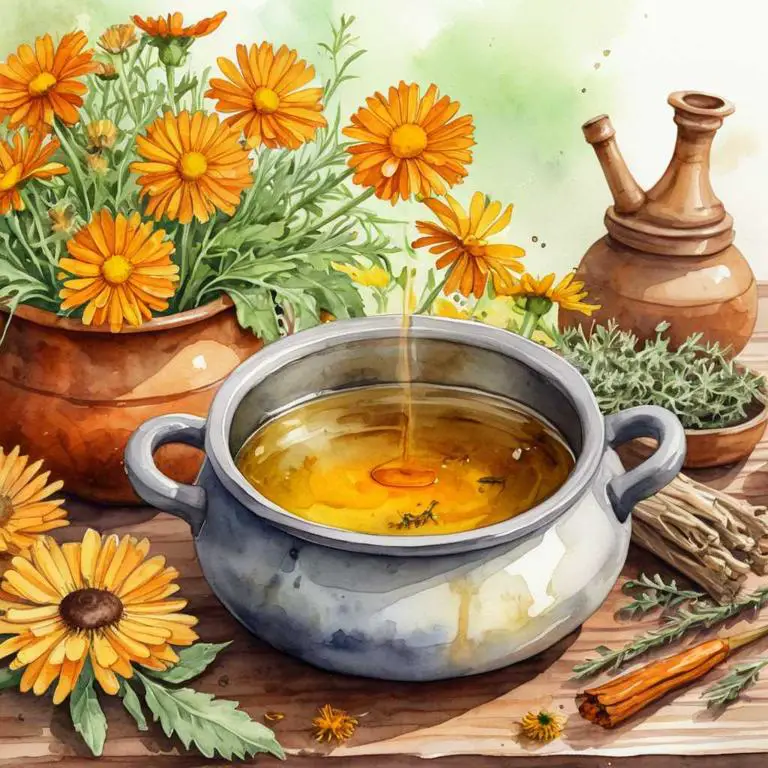
Herbal decoctions for ringworm are a natural remedy that combines herbs with hot water to create a potent liquid extract that helps alleviate symptoms of this common skin fungal infection.
By incorporating antibacterial and antifungal properties, herbal decoctions can reduce inflammation, itching, and redness associated with ringworm, allowing individuals to regain confidence in their physical appearance and daily activities.
Examples of effective herbal decoctions include those made from neem leaves, tea tree oil, and calendula flowers, which have been shown to accelerate wound healing and promote a healthy skin microbiome.
The following article describes in detail the most important decoctions for ringworm, including medicinal properties, parts of herbs to use, and recipes for preparations.
- 1. Artemisia absinthium
- 2. Calendula officinalis
- 3. Cymbopogon citratus
- 4. Echinacea angustifolia
- 5. Eucalyptus globulus
- 6. Gaultheria procumbens
- 7. Humulus lupulus
- 8. Lavandula angustifolia
- 9. Melaleuca alternifolia
- 10. Ocimum basilicum
- What is the best combination of herbal decoctions to use for ringworm?
- What ailments similar to ringworm are treated with herbal decoctions?
1. Artemisia absinthium
Wormwood decoctions helps with ringworm because it contains thujone, a compound that has been shown to exhibit antifungal properties.
The decoction is able to penetrate deep into the skin and target the fungal infection, effectively breaking down its cell walls and preventing further growth.
Additionally, wormwood's antimicrobial properties help to reduce inflammation and promote wound healing, making it an effective natural remedy for treating ringworm infections.
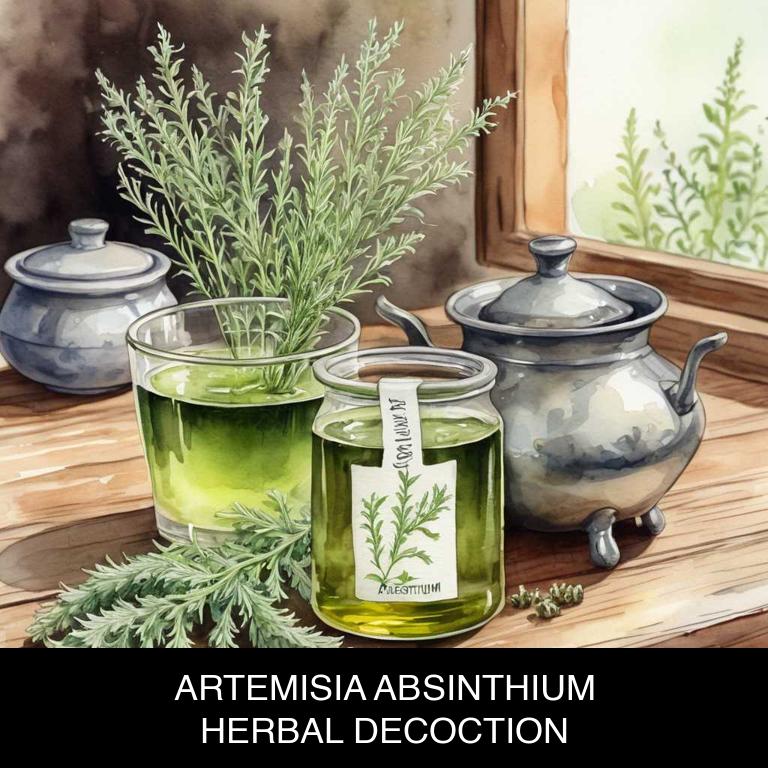
Medicinal Constituents
The list below shows the primary medicinal constituents in Artemisia absinthium decoctions that help with ringworm.
- Thujone: Thujone has been shown to possess antifungal properties, which can help combat fungal infections such as ringworm by inhibiting the growth of fungal pathogens.
- Cineole: Cineole is a terpene with antifungal and anti-inflammatory properties, which may help soothe skin irritations and reduce the severity of ringworm symptoms.
- Bornyl acetate: Bornyl acetate, a sesquiterpene found in Artemisia absinthium, has been found to possess antifungal activity, which can aid in the treatment of fungal infections like ringworm by inhibiting the growth of fungal cells.
Parts Used
The list below shows the primary parts of wormwood used to make decoctions for ringworm.
- Leaves: Used due to their antifungal and antibacterial properties, which help combat fungal infections like ringworm.
- Stems: Utilized for their similar antifungal and antibacterial properties, which aid in treating ringworm and other skin infections.
- Buds: Employed for their potential antiseptic and anti-inflammatory effects, which can help soothe and heal ringworm-infected skin.
Quick Recipe
The following recipe gives a procedure to make a basic wormwood for ringworm.
- Harvest 20-30 grams of fresh or 40-50 grams of dried artemisia absinthium leaves and flowers in the early morning.
- Chop the harvested material into smaller pieces and store it in an airtight container to preserve its potency.
- Combine the chopped leaves and flowers with 1 liter of cold water in a saucepan and bring to a boil.
- Reduce the heat to a simmer and steep the mixture for 10-15 minutes to allow the active compounds to infuse.
- Strain the decoction through a cheesecloth or a fine-mesh sieve into a clean container and discard the solids.
2. Calendula officinalis
Pot marigold decoctions helps with ringworm because of its antifungal properties, which effectively combat the fungus that causes this common skin infection.
The decoction's active ingredients, such as calendula oil and flavonoids, penetrate deep into the skin to reduce inflammation, itching, and redness associated with ringworm. Additionally, pot marigold decoctions have been shown to stimulate the body's natural healing process, promoting the growth of healthy tissue and helping to prevent scarring.
This makes it a popular natural remedy for treating ringworm and promoting overall skin health.

Medicinal Constituents
The list below shows the primary medicinal constituents in Calendula officinalis decoctions that help with ringworm.
- Carotenoids: These pigments have antimicrobial and antifungal properties, which help inhibit the growth of the fungal agent responsible for ringworm, Trichophyton spp.
- Naphthoquinones: These compounds exhibit antifungal and anti-inflammatory activities, which contribute to their effectiveness against ringworm lesions by reducing inflammation and inhibiting fungal proliferation.
- Triterpenoids: These compounds possess antifungal properties, which help combat ringworm by disrupting fungal cell membranes and inhibiting the synthesis of essential fungal molecules.
Parts Used
The list below shows the primary parts of pot marigold used to make decoctions for ringworm.
- Flowers: They are used due to their antifungal and anti-inflammatory properties, which help in treating ringworm.
- Leaves: They are used because they contain flavonoids and terpenoids that exhibit antifungal and antimicrobial activities.
- Roots: They are used due to their ability to inhibit fungal growth and reduce inflammation, making them effective in treating ringworm.
Quick Recipe
The following recipe gives a procedure to make a basic pot marigold for ringworm.
- Harvest 1 cup of fresh calendula officinalis flowers in the early morning when their potency is at its peak.
- Dry the harvested flowers in a warm oven at 100°f for 2 hours to preserve their properties.
- Measure 1 teaspoon of dried calendula officinalis flowers and add it to a heat-resistant cup.
- Pour 8 ounces of boiling water over the dried flowers and let it steep for 10 minutes.
- Strain the liquid and discard the solids to create a fragrant and medicinal decoction.
3. Cymbopogon citratus
Lemongrass decoctions helps with ringworm because of its antifungal properties, which effectively combat the fungal infection that causes this skin condition.
The essential oil present in lemongrass has been shown to inhibit the growth of fungi, reducing inflammation and promoting a healthy environment on the skin.
Additionally, lemongrass decoctions have antibacterial properties that help to prevent bacterial overgrowth, allowing for a more balanced recovery from ringworm infection.
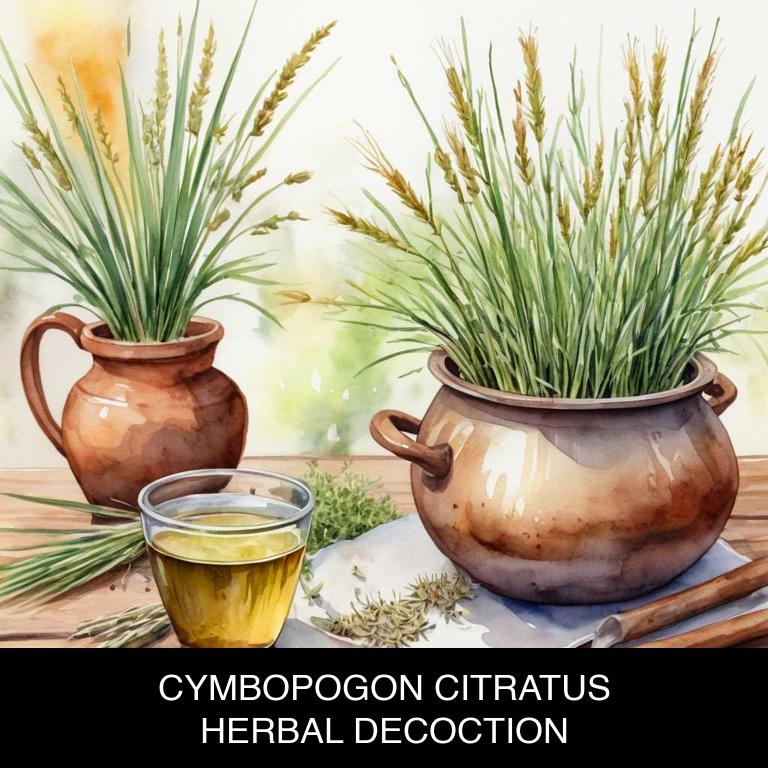
Medicinal Constituents
The list below shows the primary medicinal constituents in Cymbopogon citratus decoctions that help with ringworm.
- Citrals: Citrals, a type of monoterpene, have antimicrobial and antifungal properties that can help combat fungal infections like ringworm by inhibiting the growth of the causative pathogens.
- Limonene: Limonene, a monoterpene, has been shown to possess antifungal and antiseptic properties, which can aid in treating ringworm by reducing fungal proliferation and promoting wound healing.
- Geraniol: Geraniol, an alcohol derived from monoterpene, has antifungal and antibacterial properties that can help combat ringworm by inhibiting the growth of pathogens and promoting a conducive environment for healing.
Parts Used
The list below shows the primary parts of lemongrass used to make decoctions for ringworm.
- Leaves: They are widely used due to their high concentration of citral and other essential oils, which are known for their antifungal properties that help combat ringworm.
- Rhyzomes: The rhizomes of Cymbopogon citratus contain active compounds that exhibit antifungal and antibacterial properties, making them effective against ringworm.
- Stems: The stems of the plant are also used in decoctions due to their ability to release citral and other oils that help alleviate symptoms and promote healing of ringworm-infected skin.
Quick Recipe
The following recipe gives a procedure to make a basic lemongrass for ringworm.
- Harvest fresh leaves of cymbopogon citratus, about 30 grams, from the plant's stem and leaves.
- Rinse the leaves with cold water to remove any dirt or debris thoroughly.
- Chop the leaves into small pieces, about 1-2 mm in size, for easier infusion.
- Combine the chopped leaves with 1 liter of water in a saucepan and bring to boil.
- Reduce heat and simmer for 10-15 minutes to release the plant's active compounds slowly.
4. Echinacea angustifolia
Kansas coneflower decoctions helps with ringworm because of its potent antimicrobial and anti-inflammatory properties.
The decoction's active compounds, such as triterpenoids and flavonoids, have been shown to inhibit the growth of fungi that cause ringworm, including Trichophyton and Microsporum species. Additionally, the anti-inflammatory properties help reduce redness, itching, and swelling associated with ringworm infections.
By using Kansas coneflower decoctions topically or orally, individuals can harness its natural healing potential to effectively treat and manage ringworm symptoms.
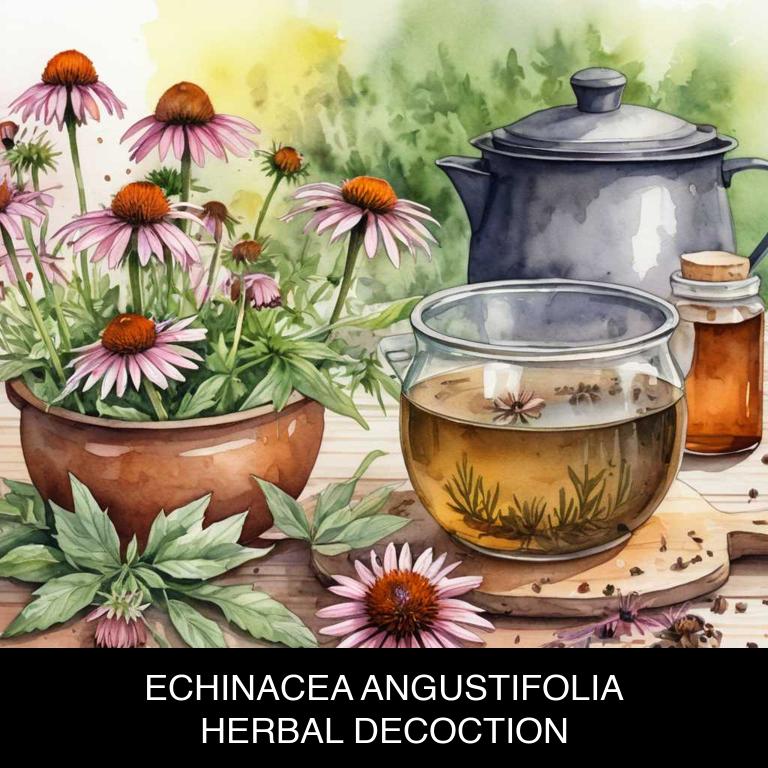
Medicinal Constituents
The list below shows the primary medicinal constituents in Echinacea angustifolia decoctions that help with ringworm.
- Iridoid glycosides: These compounds have antifungal properties that help combat fungal infections like ringworm by inhibiting the growth of the causative agent, Trichophyton.
- Alkylamides: These bioactive compounds exhibit immunomodulatory effects, enhancing the body's natural defenses against fungal infections and potentially accelerating the healing process.
- Triterpene saponins: These saponins have been shown to possess antifungal and antimicrobial properties, helping to eliminate the fungal pathogens responsible for ringworm infections.
Parts Used
The list below shows the primary parts of kansas coneflower used to make decoctions for ringworm.
- Roots: Used due to their high concentration of alkaloids and glycosides, which are believed to possess antimicrobial properties effective against ringworm.
- Leaves: Utilized for their secondary metabolites, such as flavonoids and phenolic acids, which exhibit antifungal properties that can help combat ringworm.
- Barks: Employed for their rich content of phenolic compounds and flavonoids, which have been shown to possess antiseptic and antifungal properties, beneficial in treating ringworm.
Quick Recipe
The following recipe gives a procedure to make a basic kansas coneflower for ringworm.
- Harvest echinacea angustifolia roots from a trusted supplier or cultivate them in a controlled environment.
- Clean and dry the roots to prevent contamination and preserve their medicinal properties immediately.
- Chop the dried roots into small pieces to increase their surface area for decoction.
- Simmer the chopped roots in boiling water for 10-15 minutes to extract their active compounds.
- Strain the decoction and discard the solids to separate the liquid from the plant material.
5. Eucalyptus globulus
Tasmanian blue gum decoctions helps with ringworm because it possesses antifungal properties that effectively combat fungal infections.
The decoction's active compounds, such as eucalyptol and alpha-pinene, have been shown to inhibit the growth of Candida and other fungi, which are often responsible for causing ringworm.
Additionally, Tasmanian blue gum's antimicrobial properties help to reduce inflammation and promote a healthy environment for the skin to recover from infection.
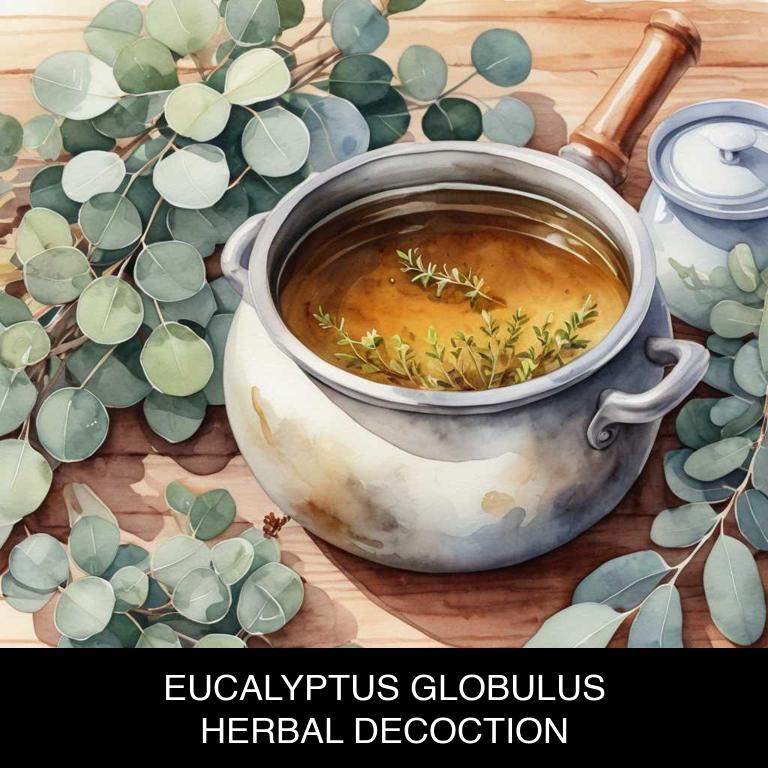
Medicinal Constituents
The list below shows the primary medicinal constituents in Eucalyptus globulus decoctions that help with ringworm.
- Cineole: Cineole has potent antifungal and antibacterial properties, helping to reduce fungal loads and prevent the spread of ringworm.
- Α-pinene: α-pinene exhibits antifungal and anti-inflammatory effects, which can help alleviate symptoms and reduce the severity of ringworm infections.
- Catechin: Catechin, a phenolic compound, has been shown to possess antifungal and antimicrobial properties, contributing to the treatment and prevention of ringworm by inhibiting fungal growth.
Parts Used
The list below shows the primary parts of tasmanian blue gum used to make decoctions for ringworm.
- Leaves: Leaves are the most commonly used part due to their high concentration of essential oils, which have antifungal and antiseptic properties that help combat ringworm.
- Barks: Barks are used for their astringent properties, which help to dry out the affected area and reduce inflammation, promoting healing of the skin.
- Roots: Roots are employed for their antifungal and antibacterial properties, which help to fight the fungal infection causing ringworm and prevent further spread.
Quick Recipe
The following recipe gives a procedure to make a basic tasmanian blue gum for ringworm.
- Harvest fresh eucalyptus globulus leaves in the early morning or late evening to ensure the highest oil content.
- Dry the harvested eucalyptus globulus leaves in a warm dry place for 7 to 10 days or until they are completely dry.
- Measure out 2 ounces of dried eucalyptus globulus leaves and place them in a heat-resistant glass bowl.
- Bring 4 cups of water to a boil and then reduce heat to a simmer for 10 to 15 minutes.
- Steep the dried eucalyptus globulus leaves in the boiling water for 5 to 7 minutes then strain the liquid.
6. Gaultheria procumbens
Wintergreen decoctions helps with ringworm because of its antifungal properties, which effectively target the fungal infection that causes this skin condition.
The decoction's active compounds, such as methyl salicylate and gallic acid, work synergistically to disrupt fungal growth and development, ultimately leading to a reduction in symptoms like itching, redness, and lesions.
As an added benefit, wintergreen decoctions may also help to soothe and calm the skin, reducing inflammation and promoting overall healing.
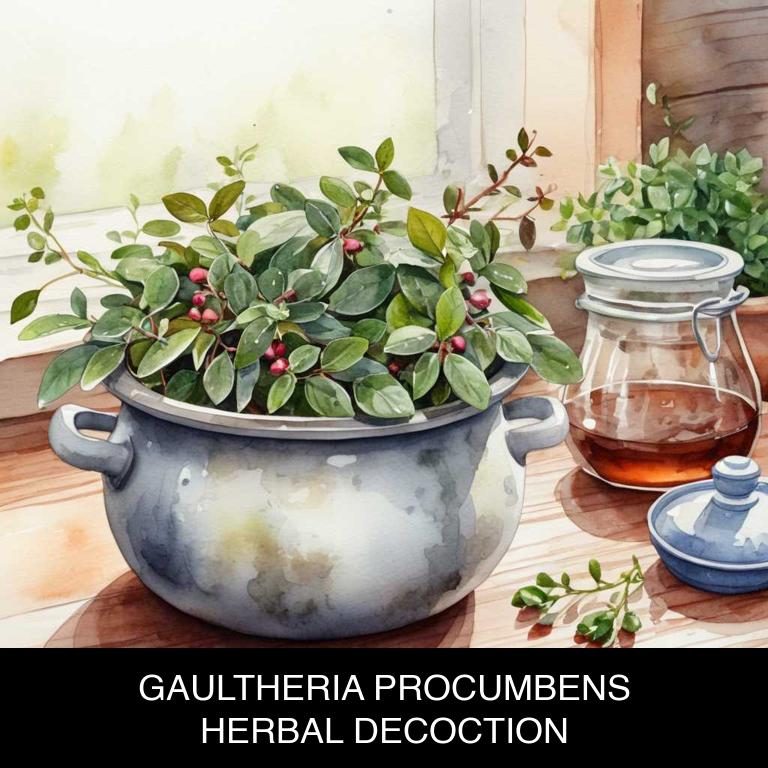
Medicinal Constituents
The list below shows the primary medicinal constituents in Gaultheria procumbens decoctions that help with ringworm.
- Phenolic acids: These compounds exhibit antifungal properties, which can help combat the fungal infection causing ringworm by inhibiting the growth and proliferation of the pathogen.
- Gaultherin: Gaultherin, a sesquiterpene glycoside, has been shown to possess antifungal and anti-inflammatory activities, which can aid in the treatment of ringworm by reducing inflammation and suppressing fungal growth.
- Gallic acid: Gallic acid, a phenolic compound, has been found to exhibit antifungal properties, which can help control the fungal infection causing ringworm by disrupting the fungal cell membrane and inhibiting its growth.
Parts Used
The list below shows the primary parts of wintergreen used to make decoctions for ringworm.
- Roots: Used due to their antifungal properties.
- Leaves: Used because they contain compounds with antifungal and antimicrobial properties.
- Stems: Used due to their antifungal and anti-inflammatory properties.
Quick Recipe
The following recipe gives a procedure to make a basic wintergreen for ringworm.
- Gather 2-4 ounces of dried gaultheria procumbens leaves and stems from a reputable supplier.
- Combine the dried gaultheria procumbens with 2 cups of boiling water in a heat-resistant container.
- Simmer the mixture for 5-10 minutes over low heat to release the active compounds.
- Strain the decoction through a cheesecloth or fine-mesh sieve into a clean container.
- Store the cooled decoction in the refrigerator for up to 24 hours before consumption.
7. Humulus lupulus
Hops decoctions helps with ringworm because of its potent antifungal properties.
The decoction contains compounds like humulone and lupulone, which have been shown to inhibit the growth of fungi that cause ringworm, including Trichophyton mentagrophytes and Microsporum canis. Additionally, hops decoction has anti-inflammatory and antimicrobial properties, which help reduce itching, redness, and swelling associated with ringworm infections.
By applying topical applications of hops decoctions, individuals may experience relief from ringworm symptoms and promote faster healing.
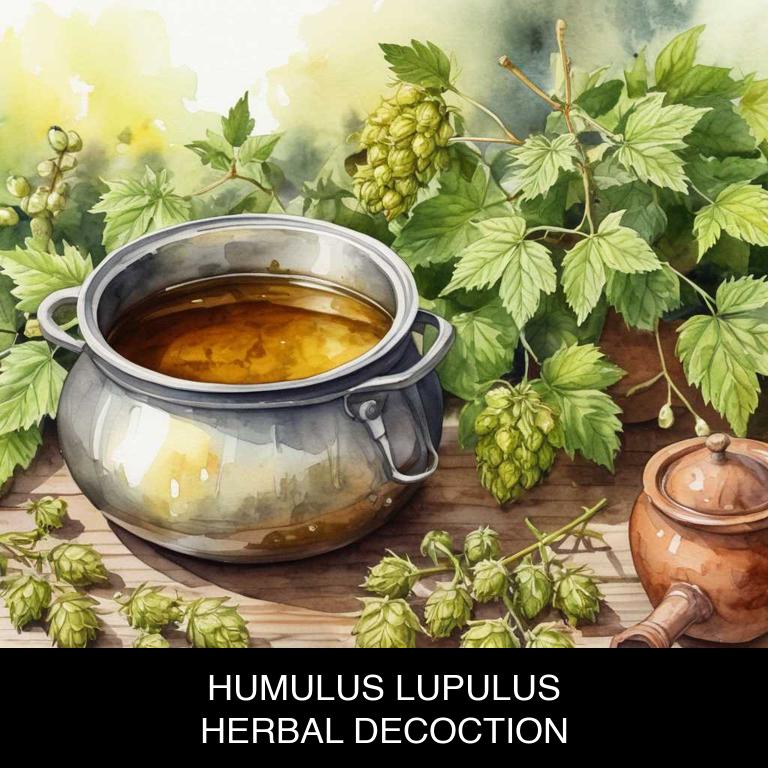
Medicinal Constituents
The list below shows the primary medicinal constituents in Humulus lupulus decoctions that help with ringworm.
- Lupulone: Lupulone, a sesquiterpene, has antifungal properties that can inhibit the growth of fungi causing ringworm, such as Trichophyton spp.
- Humulone: Humulone, a sesquiterpene, has antimicrobial properties that can help reduce fungal infections and promote healing of affected skin areas.
- Lupulin: Lupulin, a mixture of sesquiterpenes, has anti-inflammatory and antifungal properties that can help soothe and calm the skin, reducing redness and itching associated with ringworm.
Parts Used
The list below shows the primary parts of hops used to make decoctions for ringworm.
- Flowers: They are used due to their antiseptic and antifungal properties.
- Leaves: They are used due to their antiseptic and anti-inflammatory properties.
- Stems: They are used due to their antiseptic and antifungal properties.
Quick Recipe
The following recipe gives a procedure to make a basic hops for ringworm.
- Gather 1 part dried humulus lupulus flowers and 2 parts dried roots in a clean glass container.
- Measure 1 teaspoon of the mixture for every 8 ounces of boiling water.
- Simmer the mixture for 10 to 20 minutes or until the liquid has reduced by half.
- Strain the decoction through a cheesecloth or fine-mesh sieve into a clean container.
- Store the decoction in the refrigerator for up to 2 days before consuming.
8. Lavandula angustifolia
English lavender decoctions helps with ringworm because of its antifungal properties, which have been traditionally used to combat fungal infections.
The essential oils present in lavender, such as linalool and linalyl acetate, possess potent antimicrobial activity that can help to inhibit the growth of the fungus responsible for ringworm. When consumed as a decoction, these compounds are absorbed into the bloodstream, allowing them to target the affected area and promote healing from within.
This natural approach can provide effective relief from ringworm symptoms without the need for harsh chemical treatments.
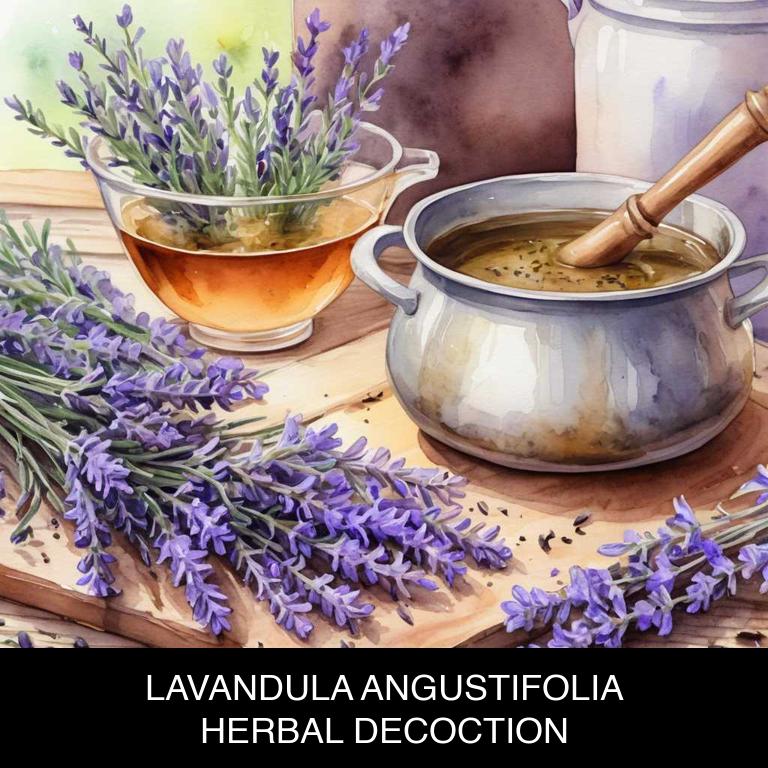
Medicinal Constituents
The list below shows the primary medicinal constituents in Lavandula angustifolia decoctions that help with ringworm.
- Linalool: This terpene helps with ringworm by exhibiting antifungal properties, which can inhibit the growth of fungal pathogens responsible for the infection.
- Linalyl acetate: This terpene also shows antifungal activity, contributing to the potential effectiveness of Lavandula angustifolia decoctions in treating ringworm.
- Caffeic acid: A phenolic compound, caffeic acid has been reported to exhibit antifungal and anti-inflammatory properties, which can aid in soothing and treating the symptoms of ringworm.
Parts Used
The list below shows the primary parts of english lavender used to make decoctions for ringworm.
- Leaves: They are used due to their antimicrobial properties which help in treating fungal infections like ringworm.
- Flowers: They are used due to their antifungal properties which help in treating fungal infections like ringworm.
- Stems: They are used due to their antimicrobial properties which help in treating fungal infections like ringworm.
Quick Recipe
The following recipe gives a procedure to make a basic english lavender for ringworm.
- Gather 2 tablespoons of dried lavandula angustifolia flowers from a reputable source.
- Combine the dried flowers with 1 quart of boiling water in a heat-resistant container.
- Steep the mixture for 5 to 7 minutes to allow the flavors to infuse.
- Strain the liquid through a cheesecloth or a fine-mesh sieve into a separate container.
- Let the decoction cool to room temperature before storing it in a sealed container.
9. Melaleuca alternifolia
Tea tree decoctions helps with ringworm because of its potent antifungal properties, specifically targeting the fungal spores that cause this skin infection.
The decoction's high concentration of terpenes and flavonoids works to disrupt the growth of the fungus, promoting a healthy environment for the skin to heal.
Additionally, tea tree decoctions can help reduce inflammation and itching associated with ringworm, providing relief and promoting faster recovery.
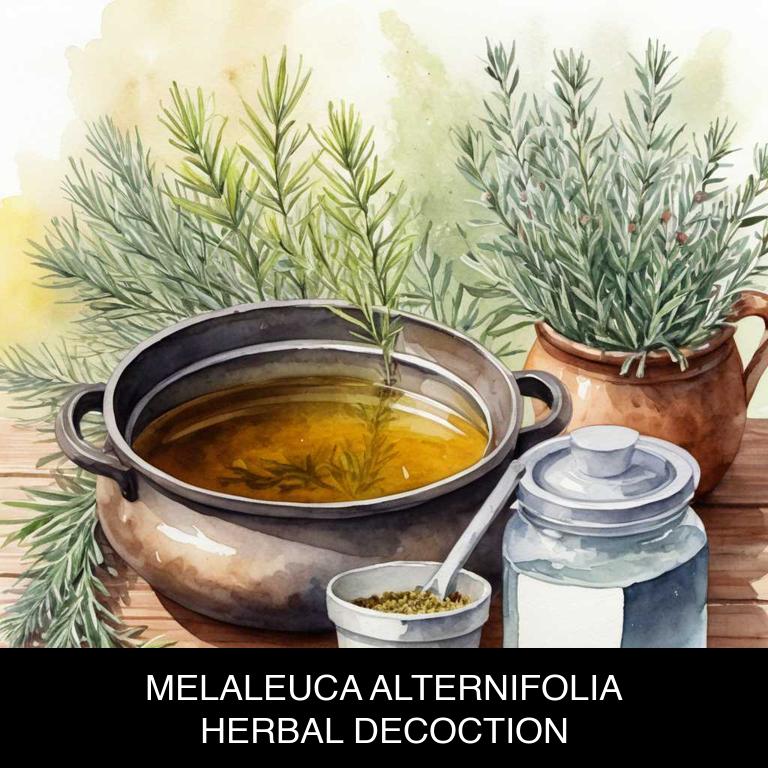
Medicinal Constituents
The list below shows the primary medicinal constituents in Melaleuca alternifolia decoctions that help with ringworm.
- Cineole: Helps with ringworm by exhibiting antifungal and antimicrobial properties, reducing the growth of the fungus causing the infection.
- Linalool: Contributes to the antifungal and antiseptic effects of Melaleuca alternifolia decoctions, helping to combat the fungal infection causing ringworm.
- Caryophyllene oxide: Exhibits antifungal activity, which helps to inhibit the growth of the fungus causing ringworm and promote healing.
Parts Used
The list below shows the primary parts of tea tree used to make decoctions for ringworm.
- Leaves: The leaves are commonly used due to their high concentration of oil, particularly tea tree oil, which has antifungal properties effective against ringworm.
- Rhyzomes: Rhyzomes are used for their medicinal properties, as they contain compounds that help to combat fungal infections, making them an effective treatment for ringworm.
- Barks: Barks are utilized due to their astringent and antiseptic properties, which aid in reducing inflammation and promoting healing of ringworm lesions.
Quick Recipe
The following recipe gives a procedure to make a basic tea tree for ringworm.
- Harvest fresh leaves from mature plants in the morning after the dew has evaporated.
- Dry the harvested leaves in a warm place with good air circulation for 7 to 10 days.
- Weigh out 5 to 7 grams of dried leaves per 250 milliliters of water and add to a pot.
- Simmer the mixture over low heat for 10 to 15 minutes to release the active compounds.
- Strain the decoction and discard the solids then let it cool before storing in a dark glass bottle.
10. Ocimum basilicum
Basil decoctions helps with ringworm because of its potent antifungal properties.
The essential oils present in basil, such as eugenol and linalool, exhibit significant inhibitory effects on fungal growth, making it an effective natural remedy for treating ringworm infections.
When taken as a decoction, these oils are released into the bloodstream, allowing them to target the fungal infection at its source, promoting rapid healing and alleviation of symptoms.
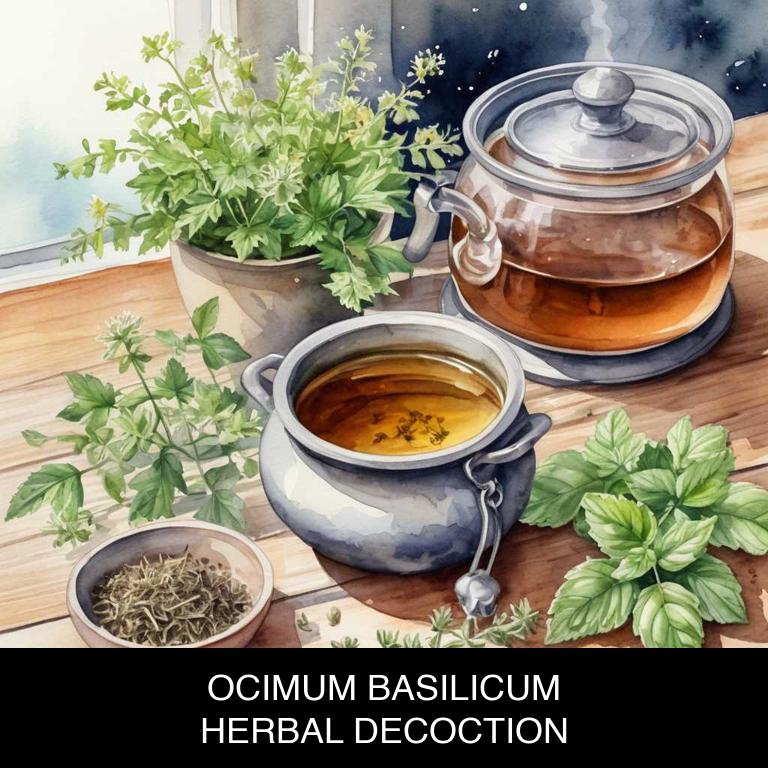
Medicinal Constituents
The list below shows the primary medicinal constituents in Ocimum basilicum decoctions that help with ringworm.
- Eugenol: Eugenol has antifungal properties that help combat the fungal infection causing ringworm.
- Borneol: Borneol has antifungal and antiseptic properties that aid in treating and preventing the spread of ringworm.
- Ursolic acid: Ursolic acid has antifungal and anti-inflammatory properties, which help reduce symptoms and promote healing in ringworm-infected skin.
Parts Used
The list below shows the primary parts of basil used to make decoctions for ringworm.
- Leaves: The leaves of Ocimum basilicum are commonly used to make decoctions for ringworm due to their antimicrobial and antifungal properties.
- Seeds: Ocimum basilicum seeds are used to make decoctions for ringworm due to their antifungal and anti-inflammatory properties, which help in treating fungal infections.
- Stems: The stems of Ocimum basilicum are used to make decoctions for ringworm due to their antiseptic and antimicrobial properties, which aid in preventing the spread of infection.
Quick Recipe
The following recipe gives a procedure to make a basic basil for ringworm.
- Choose fresh ocimum basilicum leaves with no signs of wilting or discoloration and use 1 tablespoon of leaves per 8 ounces of water.
- Crush the leaves using a mortar and pestle or a coffee grinder to release their active compounds.
- Combine the crushed ocimum basilicum with 8 ounces of boiling water in a heat-resistant glass cup or teapot.
- Allow the mixture to steep for 5-10 minutes or until the desired flavor and aroma are achieved.
- Strain the decoction through a fine-mesh sieve or cheesecloth into a cup and discard the solids.
What is the best combination of herbal decoctions to use for ringworm?
The best combination of herbal decoctions that help with ringworm is a blend of neem, tea tree, and calendula.
Neem has antifungal and antibacterial properties that help combat the infection, while tea tree oil's antiseptic properties reduce inflammation and kill bacteria. Calendula, with its anti-inflammatory and antiseptic properties, soothes the skin and promotes healing.
These decoctions can be combined in a ratio of 2:1:1, respectively, and applied topically to the affected area to promote healing and prevent the spread of the infection.
What ailments similar to ringworm are treated with herbal decoctions?
Ailments similar to ringworm/decoctions.html">ringworm/decoctions.html">ringworm that are treated with herbal decoctions are fungal infections such as athlete's foot, jock itch, and toenail fungus.
Herbal decoctions made from plants like tea tree oil, lavender, and echinacea have antifungal properties that help to combat these conditions.
Decoctions can also be used to treat other skin issues like acne, eczema, and psoriasis.